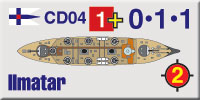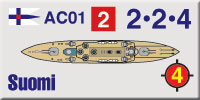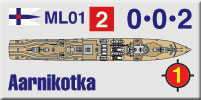Finland’s Fantasy Fleet
by Mike Bennighof, Ph.D.
November 2021
The Finnish Navy was founded in July 1918 by a group of former Tsarist officers, and for the first years of its existence the tiny force operated former Russian minesweepers in the arduous task of removing the thousands of mines laid along Finland’s coast during the course of the First World War.
But the Finns had much grander plans, and in March 1919 laid out the first of several plans to build the new force. It included the core items that would be included in almost all of the proposals that followed over the next two decades: a division of small armored coast-defense ships and a flotilla of destroyers.
Those grand plans are the subject of our downloadable Finnish Fantasy Fleet expansion, which is available for free to members of the Gold Club. It comes with 20 new “long” ship pieces for use with Second World War at Sea: Sea of Iron.
None of the ships in this set actually existed, at least not in the way we present them. All ship names are drawn from the Kalevala, Finland’s national epic.
In a world awash in surplus arms, the Finns at first sought to purchase used warships they hoped they could acquire cheaply. They faced an imminent threat from the Russian Bolsheviks and an ongoing civil war of their own, and needed an immediate solution to their naval defense needs.
 The Finns also expressed interest in the ancient German Siegfried class coast-defense ships. The High Seas Fleet had built eight of these ships during the 1880’s and 1890’s, during a period when the Navy had difficulty obtaining funding for true battleships but the Reichstag would fund coastal defense forces. These were very small ships, displacing 4,100 tons – only slightly larger than Finnish specifications. They carried three 210mm (8.2-inch) guns in three single turrets, with two of them mounted forward side-by-side. The Finns also expressed interest in the ancient German Siegfried class coast-defense ships. The High Seas Fleet had built eight of these ships during the 1880’s and 1890’s, during a period when the Navy had difficulty obtaining funding for true battleships but the Reichstag would fund coastal defense forces. These were very small ships, displacing 4,100 tons – only slightly larger than Finnish specifications. They carried three 210mm (8.2-inch) guns in three single turrets, with two of them mounted forward side-by-side.
None of them ended up in Finnish service: six were stricken just before Germany signed the Versailles Treaty and scrapped, while two became freighters for a few years, an unusual fate for a warship. Neither Britain nor France were eager to allow the Germans to sell even ancient ships to a neutral who might soon be in the market for new vessels.
Our new set includes three of these vessels, modernized for a new war (the Swedes rebuilt coast-defense ships just as old as these). They have had their two forward turrets reduced to just one, centered over the magazine, and acquired new anti-aircraft armament. But they remain very old and therefore very brittle ships.
Finnish purchasing agents sought to buy six M-class destroyers from the Royal Navy; a bureaucratic error had caused them to be offered at their scrap value. But the British agreed to sign the Washington Naval Limitations Treaty before the sale had been completed, and the British Foreign Office ruled that the deal could not be completed since the treaty forbade the sale of existing warships (though not construction of new ones). Pieces for those six destroyers are included in Second World War at Sea: Sea of Iron.
 With British assistance, Estonia gained two former Russian destroyers, big boats of the Novik class. Fast and heavily armed, they were among the most powerful warships in the Baltic for a few years and the Finns deeply envied their neighbors. The Finnish Navy wanted Noviks of their own, but barring another windfall (the Royal Navy captured the two destroyers that ended up in Estonia) the Red Navy wasn’t letting go of their remaining destroyers – pretty much the only way the Finns could have obtained these vessels would have been to seize them before the Russian Baltic Fleet fled Helsinki in 1918. But this is a fantasy fleet, and these boats figured prominently in Finnish naval dreams of the 1920’s. They’ve been modernized for service in a new war and are still very capable warships. With British assistance, Estonia gained two former Russian destroyers, big boats of the Novik class. Fast and heavily armed, they were among the most powerful warships in the Baltic for a few years and the Finns deeply envied their neighbors. The Finnish Navy wanted Noviks of their own, but barring another windfall (the Royal Navy captured the two destroyers that ended up in Estonia) the Red Navy wasn’t letting go of their remaining destroyers – pretty much the only way the Finns could have obtained these vessels would have been to seize them before the Russian Baltic Fleet fled Helsinki in 1918. But this is a fantasy fleet, and these boats figured prominently in Finnish naval dreams of the 1920’s. They’ve been modernized for service in a new war and are still very capable warships.
 The Finns also hoped to acquire at least one heavy warship from the old Imperial Russian Navy; the Poles sought an old French armored cruiser for use as a training ship and the Finns wished to do something similar. The armored cruiser Rurik had been laid up in October 1918, with the Soviets planning to rebuild her with turbine propulsion after the Russian Civil War ended and economic conditions improved. Poor maintenance led to widespread flooding, and the ship was declared worthless well before she could be reconstructed and she was scrapped in 1925. The Finns also hoped to acquire at least one heavy warship from the old Imperial Russian Navy; the Poles sought an old French armored cruiser for use as a training ship and the Finns wished to do something similar. The armored cruiser Rurik had been laid up in October 1918, with the Soviets planning to rebuild her with turbine propulsion after the Russian Civil War ended and economic conditions improved. Poor maintenance led to widespread flooding, and the ship was declared worthless well before she could be reconstructed and she was scrapped in 1925.
Rurik would have fit the Finns’ needs very well, before she was allowed to deteriorate, and the Soviets had little use for her. Had the Finns acquired her, she would have needed extensive repairs including the conversion to oil fuel and turbines planned by the Imperial Russian Navy. The Russians believed that would give her 25 knots’ speed, but the old ship would not have easily made that by 1939.
In our Finnish fantasy fleet she’s also had her armament restructured, with the 203mm (8-inch) turrets in the “wing” positions replaced by 6-inch (150mm) guns to help reduce topweight, and an array of anti-aircraft guns. She retains her main battery of four 254mm (10-inch) guns, though these likely would have been replaced by the same Bofors guns that initially armed the Ilmarinen class coast defense ships.
 Finland’s actual coastal defense ships, Ilmarinen, her sister and the projected but never-built third ship of the class, appear in Sea of Iron as they were built. Those heavy guns made the ships dangerously overweight, and came at the cost of both speed and protection. But the Finns wanted a ship with battleship-caliber guns, and rather than spend the money for a larger ship they simply jammed them – along with far too many secondary guns - on a small one. Finland’s actual coastal defense ships, Ilmarinen, her sister and the projected but never-built third ship of the class, appear in Sea of Iron as they were built. Those heavy guns made the ships dangerously overweight, and came at the cost of both speed and protection. But the Finns wanted a ship with battleship-caliber guns, and rather than spend the money for a larger ship they simply jammed them – along with far too many secondary guns - on a small one.
The original proposal for the coast defense ships called for a main armament of 203mm (8-inch) guns and a secondary armament of 105mm (4.1-inch) dual-purpose guns that could be used against air or surface targets. That would have allowed a better-balanced ship, and we’ve provided the three ships in this guise in our fantasy set.
 Rather than stuff oversized guns on an undersized ship, the Finns of course wanted a ship large enough to carry big guns, but such a vessel lay well outside the Finnish military budget. We’ve given Finland one anyway, an Italian design that the Swedes hoped to build as their new-generation coastal defense ship. She is fast and well-protected, with a main armament of six 280mm (11-inch) guns. She’s not quite a match for the old Soviet battleships but well able to turn away any Soviet cruiser. Rather than stuff oversized guns on an undersized ship, the Finns of course wanted a ship large enough to carry big guns, but such a vessel lay well outside the Finnish military budget. We’ve given Finland one anyway, an Italian design that the Swedes hoped to build as their new-generation coastal defense ship. She is fast and well-protected, with a main armament of six 280mm (11-inch) guns. She’s not quite a match for the old Soviet battleships but well able to turn away any Soviet cruiser.
 More within the grasp of Finland’s naval budget was the hope to build six modern destroyers. The Finns looked closely at Italian designs; desperate for hard currency, Mussolini’s Italy offered very generous prices and payment terms to foreign customers on military hardware, at times selling first-rate weapons and leaving the Italian armed forces with aging second-rate equipment. The Finns considered buy a half-dozen Spica class torpedo boats (Sweden ended up buying two of them) or six full-sized destroyers. Our set gives the Finns six Soldati-class destroyers, the top-of-the-line Italian destroyer in 1939. They are large boats, but have a comparatively light armament given their size. More within the grasp of Finland’s naval budget was the hope to build six modern destroyers. The Finns looked closely at Italian designs; desperate for hard currency, Mussolini’s Italy offered very generous prices and payment terms to foreign customers on military hardware, at times selling first-rate weapons and leaving the Italian armed forces with aging second-rate equipment. The Finns considered buy a half-dozen Spica class torpedo boats (Sweden ended up buying two of them) or six full-sized destroyers. Our set gives the Finns six Soldati-class destroyers, the top-of-the-line Italian destroyer in 1939. They are large boats, but have a comparatively light armament given their size.
 Finnish coast-defense strategy relied heavily on huge artillery pieces in fixed fortifications covering extensive minefields. The Finns built a pair of small minelayers in 1941, at the Crichton yard in Turku, but wanted much larger vessels. They receive here a pair of big minelayers based on the Polish Gryf. In practice the Polish ship proved oversized and overcomplicated, attempting to cram too many missions into too small a hull. The small (300 tons’ displacement) Finnish ships, by contrast, saw extensive service and proved very useful. But sometimes what we want isn’t really what we need. Finnish coast-defense strategy relied heavily on huge artillery pieces in fixed fortifications covering extensive minefields. The Finns built a pair of small minelayers in 1941, at the Crichton yard in Turku, but wanted much larger vessels. They receive here a pair of big minelayers based on the Polish Gryf. In practice the Polish ship proved oversized and overcomplicated, attempting to cram too many missions into too small a hull. The small (300 tons’ displacement) Finnish ships, by contrast, saw extensive service and proved very useful. But sometimes what we want isn’t really what we need.
Finnish Fantasy Fleet also includes a few scenarios for you to play with these ships. It’s free to Gold Club members.
Click here to join the Gold Club right now!
Sign up for our newsletter right here. Your info will never be sold or transferred; we'll just use it to update you on new games and new offers.
Mike Bennighof is president of Avalanche Press and holds a doctorate in history from Emory University. A Fulbright Scholar and NASA Journalist in Space finalist, he has published a great many books, games and articles on historical subjects; people are saying that some of them are actually good.
He lives in Birmingham, Alabama with his wife, three children, and his Iron Dog, Leopold.
Want to keep Daily Content free of third-party ads? You can send us some love (and cash) through this link right here.
|
